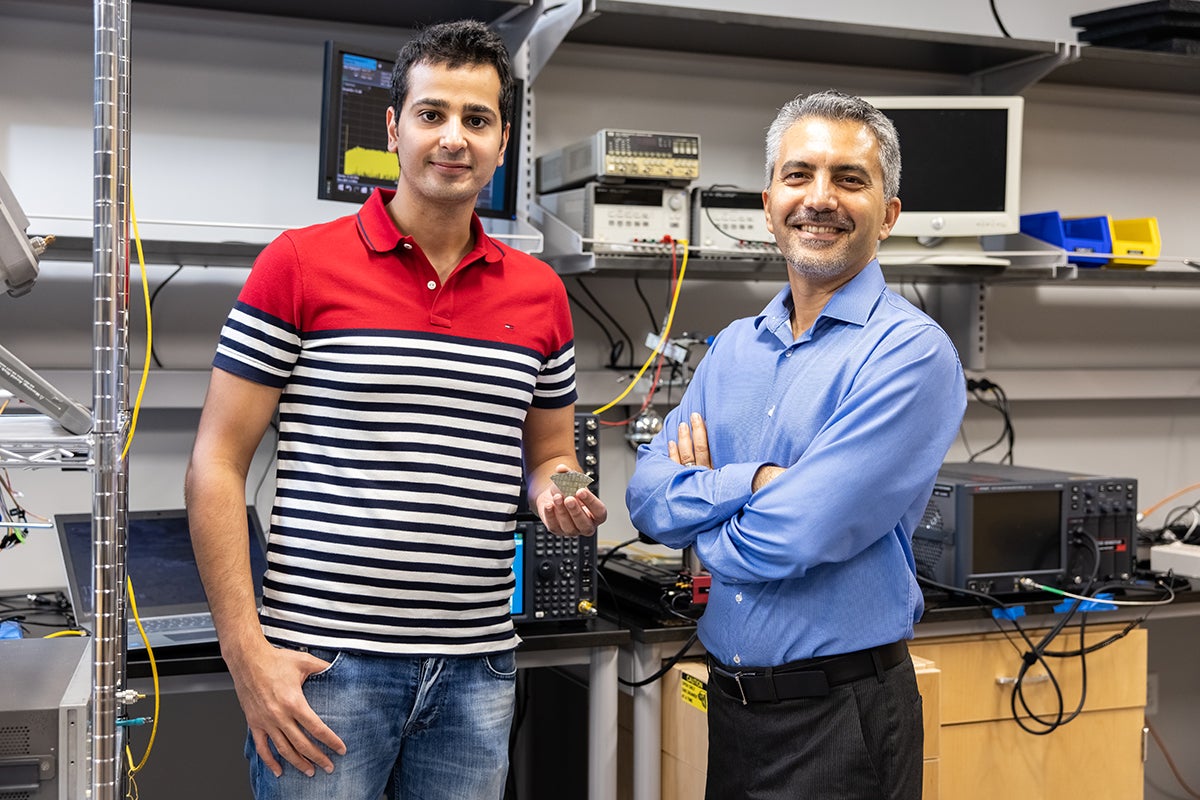To meet the growing energy needs of the internet of things (IoT) and wireless communication systems, University of Central Florida researchers have developed a technology for converting radio frequency signals into direct current electricity.
The technology can reduce the electronic industry’s reliance on batteries and broaden the expansion of the IoT and its energy needs.
Today’s wireless systems rely on batteries, which has an energy supply that will soon be outpaced by the growth of communication data and devices in the IoT, says the technology’s lead inventor, Reza Abdolvand, professor and chair of UCF’s Department of Electrical and Computer Engineering.
“The growth is also limiting availability in the radio frequency spectrum,” he says. “One reason is that today’s systems use part of their limited power budget to sense and monitor the amount of signal power they transmit and receive instead of solely amplifying the signal. This sensing is both for regulation purposes and maintaining transceiver performance.”
To solve these issues, the UCF researchers developed a technology that integrates power scavenging and spectrum sensing capabilities for ultra-low power applications. The resulting passive module would eliminate the need for power-hungry radio frequency sensing modules.
The invention harvests ambient energy, specifically radio frequency electromagnetic waves, the most abundant form of communication among IoT nodes and hubs.
Radio frequency to direct current conversion operates in a sub-millimeter footprint and within a lithographically defined frequency range. To address the spectrum availability issue, the researchers enabled the invention to handle more intelligent data transmission between the IoT nodes and hubs so that the IoT node “understands” the frequency occupancy in its vicinity.
In an example application, wake-up radios, which remain dormant and ideally consume zero power before being activated, could be built with the UCF zero-power radio frequency-to-direct current conversion scheme and scavenge energy from the radio frequency power radiated by nearby modules.
Furthermore, the radiated radio frequency power, otherwise wasted, could be scavenged by the module and stored in a capacitor or a battery.
Abdolvand and co-inventor Hakhamanesh Mansoorzare, a postdoctoral researcher in Abdolvand’s lab, worked with UCF’s Office of Technology Transfer (OTT) to file a patent application in July 2022 with the United States Patent and Trademark Office (USPTO). To help with the patent expenses, the team recently secured the new Allowable Patent Expenses (APEX) award from the U.S. National Science Foundation (NSF).
“I am truly excited that this technology, which is an offshoot of my Ph.D., could help towards a more sustainable future,” Mansoorzare says.
For more information about the invention, see the technology sheet. A prototype of the technology is available, and the team is currently seeking partners for licensing or research collaboration.
About the APEX Award
Intellectual property protection is supported by an Allowable Patent Expenses (APEX) award from the NSF, as part of its Partnerships for Innovation — Technology Translation (PFI-TT) program. The APEX award assists current PFI-TT grantees in their technology commercialization efforts by funding qualified university patent expenses.
“This is the first time that UCF has received APEX funding to defray patent expenses,” says Raju Nagaiah, the Office of Technology Transfer assistant director who is managing the technology for patenting and commercialization. “It is going to cover the expenses related to filing and prosecution of the invention.”
The funding for the recently rolled out APEX program was secured by Abdolvand working with the Office of Technology Transfer and is an example of collaboration and innovation thriving at UCF, says Office of Technology Transfer Director Svetlana Shtrom.
“Applying for a patent can be quite expensive and involves contracting attorneys specializing in patenting such technologies,” she says. “The APEX supplemental funding will reduce the strain on the university’s intellectual property budget and will allow us to protect a greater number of promising new innovations.”
In 2020 and 2021, Abdolvand secured $249,587 in PFI-TT funding to support his ongoing research to develop piezo-semiconductor acoustoelectric microdevices. Under the PFI-TT award, Abdolvand’s research team developed an invention for ultra-low power and miniaturized wireless transceivers.
Once the innovation was developed, Abdolvand and Mansoorzare worked with OTT to file a patent application in July 2022 with the USPTO. Then in September, the collaboration continued between the research and OTT teams, resulting in a $49,916 APEX supplemental award from NSF to cover the patent expenses. The researchers have also submitted a second invention disclosure to OTT for patent protection.
Researcher Credentials
Abdolvand leads the UCF Dynamic Microsystems Lab, which focuses on extending and applying hybrid integrated microsystems to various technology areas, including radio frequency, biomedical, and wireless sensing. The lab provides expertise in designing and fabricating microelectromechanical systems. He received his doctorate in electrical engineering from the Georgia Institute of Technology and joined UCF’s Department of Electrical and Computer Engineering, part of the College of Engineering and Computer Science, in 2014.
Mansoorzare received his doctorate in electrical and electronics engineering from UCF in 2021 under Dr. Abdolvand’s advisement and is a postdoc in the same group since then.




